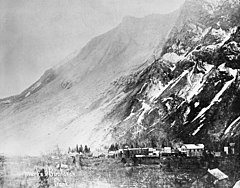 The town of Frank and Turtle Mountain on April 30, 1903, one day after the slide | |
| Date | April 29, 1903 |
|---|---|
| Time | 4:10 a.m. MST |
| Location | Frank, District of Alberta, North-West Territories (now the province of Alberta), Canada |
| Coordinates | 49°35′28″N 114°23′43″W / 49.59111°N 114.39528°W |
| Deaths | 70–more than 90 |
| Website | Frank Slide Interpretive Centre |
The Frank Slide was a massive rockslide that buried part of the mining town of Frank in the District of Alberta of the North-West Territories,[nb 1] Canada, at 4:10 a.m. on April 29, 1903. Around 44 million cubic metres/110 million tonnes (120 million short tons) of limestone rock slid down Turtle Mountain.[1] Witnesses reported that within 100 seconds the rock reached up the opposing hills, obliterating the eastern edge of Frank, the Canadian Pacific Railway (CPR) line and the coal mine. It was one of the largest landslides in Canadian history and remains the deadliest, as between 70 and 90 of the town's residents died, most of whom remain buried in the rubble. Multiple factors led to the slide: Turtle Mountain's formation left it in a constant state of instability. Coal mining operations may have weakened the mountain's internal structure, as did a wet winter and cold snap on the night of the disaster.
The railway was repaired within three weeks and the mine was quickly reopened. The section of town closest to the mountain was relocated in 1911 amid fears that another slide was possible. The town's population nearly doubled its pre-slide population by 1906, but dwindled after the mine closed permanently in 1917. The community is now part of the Municipality of Crowsnest Pass in the Province of Alberta and has a population around 200. The site of the disaster, which remains nearly unchanged since the slide, is now a popular tourist destination. It has been designated a provincial historic site of Alberta and is home to an interpretive centre that receives over 100,000 visitors annually.
Cite error: There are <ref group=nb> tags on this page, but the references will not show without a {{reflist|group=nb}} template (see the help page).